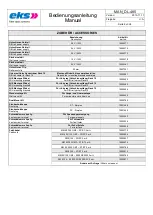
Bedienungsanleitung
Manual
MAN_DL-485
Version:
2019-11-11
Freigabe:
U.A.
Seite 6 von 8
ABMESSUNGEN / DIMENSIONS
ANSCHLUSSHINWEISE / HARDWARE INSTALLATION
Rasten Sie das Gerät auf eine Tragschiene DIN EN auf
und überprüfen Sie den sicheren Halt.
Verbinden Sie den ankommenden Lichtwellenleiter mit
dem optischen Empfänger (RX) und den abgehenden
LWL mit dem optischen Sender (TX).
Benutzen Sie nur passende LWL-Anschlussstecker
und verwenden Sie die beigefügten Stopfen um nicht
benutzte optische Stecker und Kupplungen vor Verun-
reinigungen und Staub zu schützen. Falsche Steckver-
binder können Schäden an den optischen Anschlüssen
verursachen.
Knicken Sie die LWL-Kabel nicht zu stark und beachten
Sie deren Biegeradius.
Die Datenleitungen können wahlweise an den Schraub-
klemmen oder am SubD9 Stecker angeschlossen wer-
den.
Stellen Sie mit den DIP Schaltern die gewünschte Kon-
figuration ein.
Schließen Sie die Versorgungsspannung gem. Typen-
schild an die Klemmen PWR1 (+) und/oder PWR2 (+)
sowie GND (-) an.
PWR1 und PWR2 sind redundante Versorgungsspan-
nungseingänge mit Verpolungsschutz.
Nach dem Einschalten der Versorgungsspannung
leuchten alle LEDs (Selbsttest). Wenn die rote FAIL
LED neben dem optischen Anschluss erlischt, ist die
optische Verbindung hergestellt.
Snap the system onto the DIN EN rail and check that it
is securely fastened.
Connect the incoming fiber to the optical receiver (RX)
and the outgoing fiber to the optical transmitter (TX).
Use only suitable optical connectors and apply the at-
tached plugs to unused optical connectors and cou-
plings to prevent them from dust and impurity. Using
wrong connectors can damage the optical joints.
Don´t bend the optical fibers too much and refer to the
specified bending radius.
Data wires can be connected to the screw terminal or
to the SubD9 connector alternatively.
Use the DIP switches to set the desired configuration.
Supply the voltage specified on the type label to the ter-
minals PWR1 (+) and/or PWR2 (+) and GND (-).
PWR1 and PWR2 are redundant power inputs with
reverse voltage protection.
After switching on the power supply, all LEDs will light
up for a self-test.
The FAIL LED beneath the optical connection will go off
to affirm that the optical connection is established.


























